Discussion On Commonwealth Bank Of Australia Sustainability Policies
Question
Task:
CBA Background Information: The Commonwealth Bank of Australia (abbreviated CBA or CommBank) is an Australian multinational bank with businesses across New Zealand, Asia, the United States and the United Kingdom. It provides a variety of financial services including retail, business and institutional banking, funds management, superannuation, insurance, investment and broking services. The Commonwealth Bank is the largest Australian listed company on the Australian Securities Exchange as of August 2015 with brands including Bankwest, Colonial First State Investments, ASB Bank (New Zealand), Commonwealth Securities (CommSec) and Commonwealth Insurance (CommInsure). Commonwealth Bank is also the largest bank in the Southern Hemisphere.
Founded in 1911 by the Australian government and fully privatised in 1996, the Commonwealth Bank is one of the "big four" Australian banks, with National Australia Bank (NAB), ANZ and Westpac. The bank listed on the Australian Stock Exchange in 1991.
The former global headquarters of Commonwealth Bank were the Commonwealth Trading Bank Building on the corner of Pitt Street and Martin Place, Sydney, which was refurbished from 2012 for retail and commercial uses, and (from 1984 to 2012) the State Savings Bank Building on Martin Place, which was sold in 2012 to Macquarie Bank. The headquarters were moved to Tower 1, 201 Sussex Street and two new nine-storey buildings which were built at the site of the former Sega World Sydney, in Darling Harbour on the western side of Sydney's city centre.
Commonwealth Bank is today announcing new and updated environmental, social and governance (ESG) policies and practices that support our efforts to make a positive impact through the way we do business.
Commonwealth Bank Chief Executive Ian Narev said: “Commonwealth Bank has been around for more than a century. We want to continue to be successful well into the future. That means we need to be cognisant of the long-term impact our business has on the economies and communities in which we operate. An important part of that is rigorously and consistently examining our lending and investment decisions to understand and assess environmental and social impacts. The policies and practices that we are announcing today enable us to do that. They also provide transparency so we can be held accountable by our stakeholders for the decisions we make.”
The new and updated policies and practices have been devised under Commonwealth Bank Group’s 2016-2018 Corporate Responsibility Strategy which guides us in achieving our vision to excel at securing and enhancing the financial wellbeing of people, businesses and communities.
Tackling climate change
Commonwealth Bank has had a Group Environment Policy since 2001. It has been updated to acknowledge international efforts to limit global warming to two degrees Celsius, and the need to transition from traditional economic models, and the world’s current energy mix, to low carbon and renewable alternatives.
The updated policy expresses our commitment to support the transition to a low carbon economy and builds on our existing commitments to: reduce our direct environmental impacts; apply comprehensive environmental risk management frameworks to our lending and investing decisions; use our position to influence the companies we lend to and invest in with respect to their impact on the environment; and actively support businesses and technologies that reduce dependence on fossil fuels and mitigate the effects of climate change. The policy will be reviewed annually.
Research and review a sustainability policy 2015 of Commonwealth Bank of Australia andrecommend policy options. Submit a report that covers the following.
1. Determine the scope and direction of the sustainability policy:
- Define the scope of the policy.
- You will be observed gathering information from a range of sources to plan and develop the policy. Sources may include business website, colleagues, consultants, regulators, industry associations, legislation and compliance requirements. You must participate in discussions to elicit the views of others.
2. Make recommendations for policy options:
- Review the effectiveness of each option, such as by using a SWOT (Strength, Weakness, Opportunity and Threat) analysis.
- Conduct a cost–benefit analysis.
- Outline time frames for implementing the policy.
3. Develop a sustainability policy for Commonwealth Bank of Australia. The policy must:
- Incorporate the organisation’s commitment to sustainability as a part of business planning.
- Implement resource efficiency, minimising resource use, and reducing toxic material and use of hazardous chemicals.
- Employ life cycle management approaches and continuous improvement.
4.Obtain agreement from stakeholders on methods of implementation, outcomes and performance indicators. This may include documenting the performance measures (KPIs) and indicating the checkpoints. Agreement can be obtained via a questionnaire or email confirmation. You can refer to the principles of SMART in creating your own performance indicators of sustainability management in CBA.
Note: Commonwealth Bank of Australia Sustainability Policy is available:
https://www.commbank.com.au/content/dam/commbank/about-us/shareholders/pdfs/corporate-responsibility/2017/2017-corporate-responsibility-report.pdf
5.You will be observed communicating the workplace sustainability policy in an oral discussion with stakeholders, including those involved in its implementation. This may include a communication plan with accompanying notes for the presentation in a meeting or planning day. As part of your communication, you must:
- Promote the policy and outline the expected outcomes.
- Outline the procedures required to implement the policy.
- Assign responsibilities for implementing the policy to track continuous improvements in sustainability approaches.
- Develop communication procedures to help implement sustainability policy
- Present the information using language appropriate to the audience.
6.Submit an implementation report outlining the strategies you undertook for continuous improvement in resource efficiency, including employing life cycle management approaches.
Submit a report reviewing the sustainability policy and provide feedback to stakeholders.
7. Review the implementation of the policy and procedures. This includes:
- Investigate and document the outcomes, including successes by reviewing/ researching the current CBA sustainability performance and corporate governance
- Identify trends and areas that require remedial action for continuous improvement of performance.
- Provide feedback to key stakeholders, such as in a meeting or presentation. You will be observed participating in discussions when you provide the feedback.
8.Modify the policy and procedures to ensure improvements are made. This may require adjusting the policy or resource allocation based on feedback.
Answer
Executive Summary
The Commonwealth Bank of Australia is a large financial organization playing a great role in Australia and other nations along with multiple stakeholders. The Commonwealth Bank of Australia sustainability are renewed and revised after a specific period and the implementation of the new policy has been analyzed. A new policy on supply chain development and making the supply chain more environments friendly has been proposed. Threats like lack of funds and the lack of awareness of people are major issues that need to be addressed and monitored. Communication is key and must be used in the policy implementation process along with the strategies that develop risk management frameworks to avoid potential issues and threats. The company has performed well in recent years yet a few recommendations on developing policies for people is provided.
1. Introduction
The Commonwealth Bank of Australia is one of the central financial organizations that are responsible much in operating financial transactions for several multinational organizations located in and out of the provinces in Australia. As major issues of the current world, the use of extensive natural resources in operating daily practices has concerned several organizations and the Commonwealth Bank of Australia sustainability has been no exception. The rise of awareness to proliferate policies for developing sustainable practices has influenced the stated bank of Australia to use various strategies and activities on Commonwealth Bank of Australia sustainability.
This particular report is going to focus on three specific sections and develop a critical and vivid understanding on the planning and developing of a Commonwealth Bank of Australia sustainability policy that suits the current trends and practices of the bank. The report intends to focus on communicating and implementing the recommended policy alongside monitoring and reviewing the same for better future outcomes.
2. Discussion
2.1 Planning and Developing a Commonwealth Bank of Australia sustainability Policy
2.1.1 What is the scope and direction of the Commonwealth Bank of Australia sustainability policy? Discuss.
In order to tackle the current global climate change issues, the stated organization has been keen in developing strategies and policies that suit the needs of the stakeholders alongside being highly eco-friendly and sustainable in nature(Moving to Australia. The Commonwealth Bank, 2020). The scope of the current Commonwealth Bank of Australia sustainability policy that the organization has adapted is related to the environment, social and governance policies that aims to build the company’s overall reputation higher by making all practices and activities highly eco-friendly, ethical and beneficial to all stakeholders. The ESG policies involve climate change mitigating strategies, the whistleblower policy, the Financial Assist Domestic Violence policy, and others.
Considering the nature and impact of the Commonwealth Bank of Australia sustainability policy the scope of the policy can be elucidated that it will help in reducing the temperature by two degree Celsius that is a major change in the area of climate change mitigation practices(Corporate Responsibility Report , 2017). Moreover, the policy sets out new activities that help in empowering the social practices that benefits the use of natural resources in limitations and help in conserving the human rights, non-renewable resources and balance carbon emission. On a critical note, it has been observed that many people are observing several issues in the ESG policy schemes. Forbes contributor Kate Ashford (2019) notes that screening the funds for the ESG requires more attention and action. On a micro level, this could be difficult for financial advisors who are working with companies and other banks and are following the Commonwealth Bank of Australia sustainability policy. There is a gap in social awareness and people are not fully aware of the policy schemes. This also affects the supply chain and that lacks proper Commonwealth Bank of Australia sustainability chains of actions.
2.1.2 Making recommendations (report) for policy options
Considering the nature and the consequences of the policy that has been discussed earlier, this particular section of the report is providing a few recommendations to better the policy and help in receiving outcomes that are more positive. Some of the recommendations are listed below.
- Firstly, it is recommended to make the policies more people friendly and develop activities that common people can easily perform in their day-to-day life.
- It is recommended to opt for a clearer eco-friendly supply chain that will help in reducing the waste and control carbon emission at all levels and stages of operations.
Reviewing the effectiveness of each option:
Policy name: Supply Chain Development Policy
For developing a better supply chain of resources that are involved in the day-to-day activities
SWOT
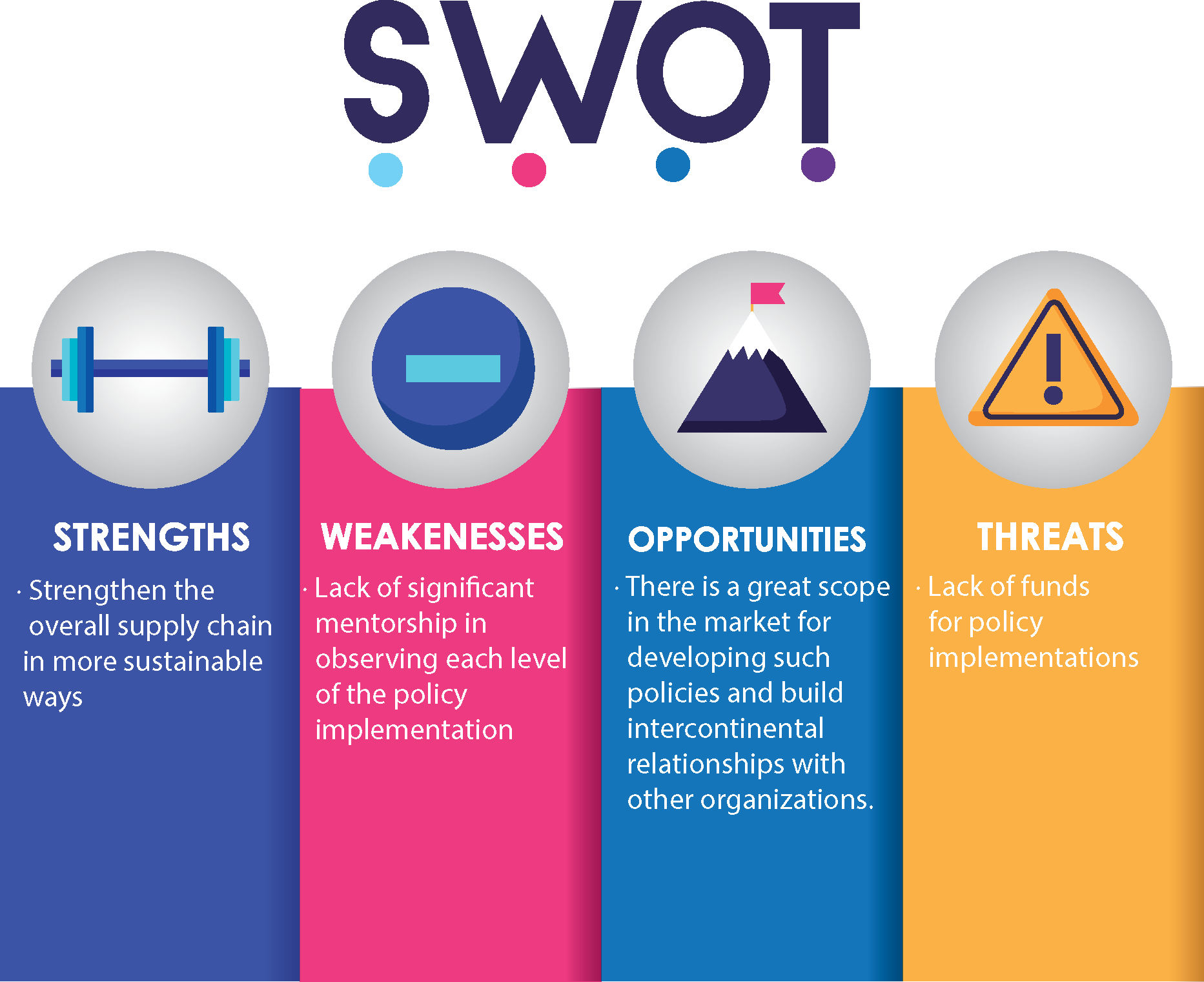
In terms of assessing the cost benefit analysis for this policy option, it can be stated that immediate investment is required to set up the eco-friendly infrastructure for the supply of resources and channeling their flow in the market.
|
Cost |
Benefit |
|
The probably demerit stands as the immediate expenses to set up the Commonwealth Bank of Australia sustainability infrastructure that will worth the investment considering the great benefits that the Bank will enjoy in future. |
Investing on this policy will be beneficial, as it will help in making the entire supply chain highly environment friendly and reduce the use and implementation of non-renewable natural resources. |
The time- frame for implementing this process would be of no less than 6 months.
|
Time (6 months) March 2020 – August 2020 |
Activities |
|
1st March to 20th March |
Conduct market research and investigate the current supply chain activities |
|
21st march to 20th April |
Identify the supply chain processes and opt for eco friendly set ups, resources and tools |
|
22nd April to 30th June |
Each of the resources and their sources need to be changed into more environmental friendly modes |
|
1st July to 20th August |
Monitoring of the new supply chain policy in the light of Commonwealth Bank of Australia sustainability |
Policy name: People Oriented Policy
For developing policies that are easily understood by people and can be followed with simple guidelines
SWOT
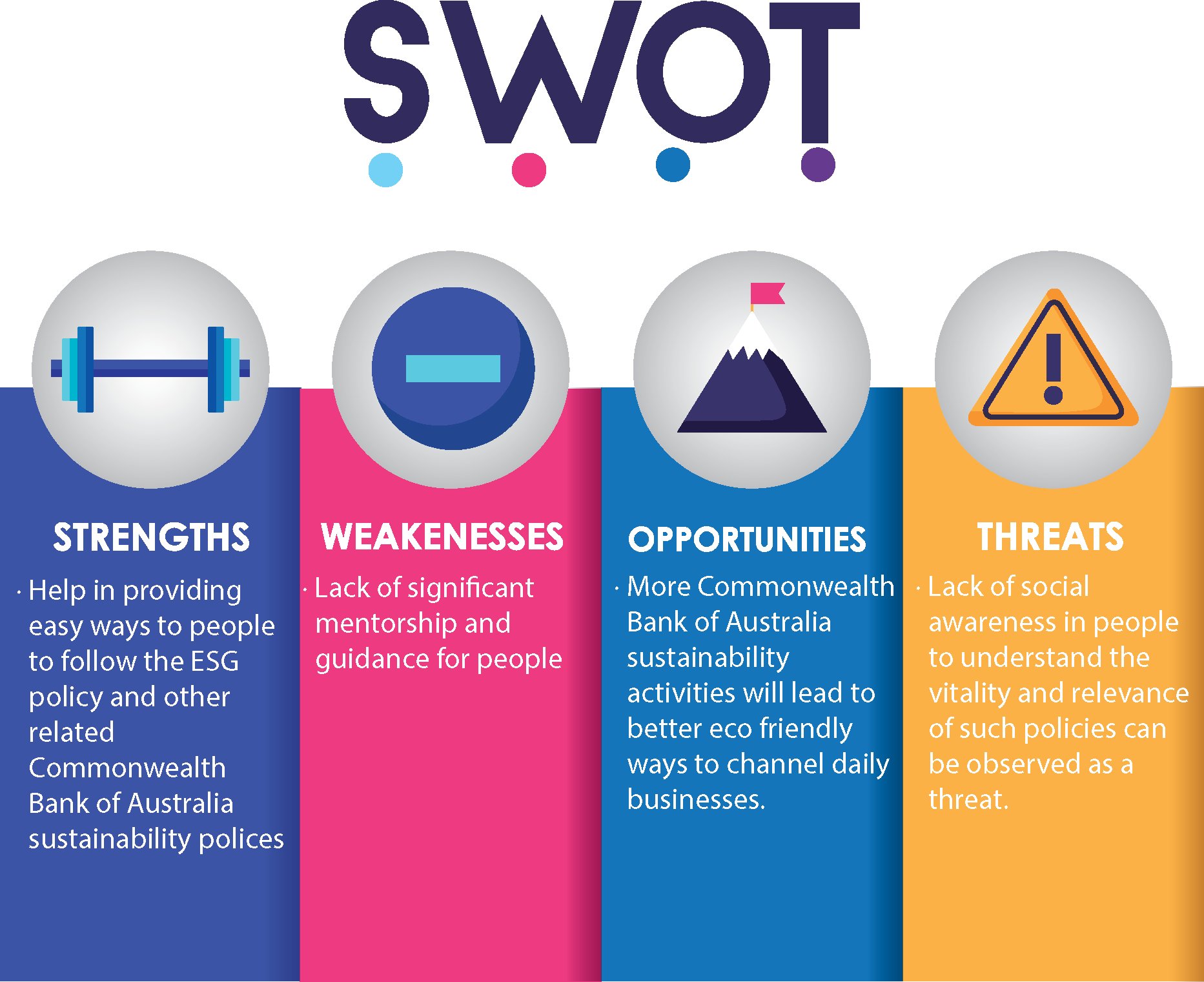
Cost benefit analysis for this policy-
|
Cost |
Benefit |
|
There is sufficient investment that can cost much while implementing the project. This can cause extra investment and would require time to complete. |
The benefits will be enjoyed in the form of social development and a smooth flow of sustainable actions from people. |
Timeframe
|
Time (2 months) March 2020 – April 2020 |
Activities |
|
1st march to 10th march |
Conduct a basic ground research on the existing policies |
|
11th March to 30th March |
Develop strategies to communicate with the locals and the people |
|
1st April to 15 April |
Implement new ways and policy frameworks that are people friendly |
|
16th April to 30th April |
Allow the people to observe and test the policies |
1.3 Developing a Commonwealth Bank of Australia sustainability policy
Commonwealth Bank of Australia sustainability policy can be related to many agendas, and principles that commingle to provide benefits to the overall business as well to the stakeholders. It is important to develop a Commonwealth Bank of Australia sustainability policy that benefits the stakeholders that involve the common people as well as the ones who are invariable or vicariously associated with the Bank and their daily activities. The policy for the bank can be as follows-
Developing the supply chain-, a policy for making all resources of CBA’s highly sustainable and environmentally friendly.
It is through this particular policy that the bank’s commitment to the Commonwealth Bank of Australia sustainability actions and practices will be involved in their overall planning of the business. The resource efficiency can be well managed as the supply chain will be thoroughly assessed and modified into eco-friendly chains of activities. This would further help in minimizing the use of resources, managing wastes and improve the life cycle of the resources that are going to be used regularly by the bank and by their related stakeholders.
2.1.4 Obtaining agreement from stakeholders
A crucial part on implementing the policy requires an official agreement from the stakeholders who are going to be affected or will be working for the policy. This can be done by gathering agreements through surveys conducted by Emails or digital social media platforms. Understanding and identification of the Key performance indicators (KPIs) is required alongside assessing the employee interests. A simple questionnaire can be attached to the survey for receiving the agreement from the stakeholders.
2.2 Communicating and implementing the policy
2.2.1 A Stakeholder Communication plan
Communicating the workplace sustainability policy is not easy and certainly requires effective means and ways of communication to allow the stakeholders get fully aware of the policies and their benefits. It is only by communicating well and effectively to the stakeholders that the vitality and relevance of the policy will be felt and put into practice.
The first step is to promote the idea of the policy. Elucidate the concept and the policy framework in a way that everyone understands in a meeting. It is also necessary to outline the procedures that are needed to implement the policy. This can involve choosing a certain means of communication and discuss with the policy makers and the employees, the potential benefits and the outcomes of the implementation of the stated policy.
A certain procedure must be followed to implement the policy. It is essential to understand the stakeholders and their individual duties, assessing their potential and performances and eventually allocating the work to each employee to fulfill the implementation objectives or criteria. It must be noted that a strategic risk management activity/ strategy will be actively brought into practice to identify with potential risks, threats and take necessary mitigating steps to eradicate them(8 BENEFITS OF RISK MANAGEMENT (BEYOND PROJECT CONTROL), 2017). The implementation of the policy will involve few important steps that are listed below.
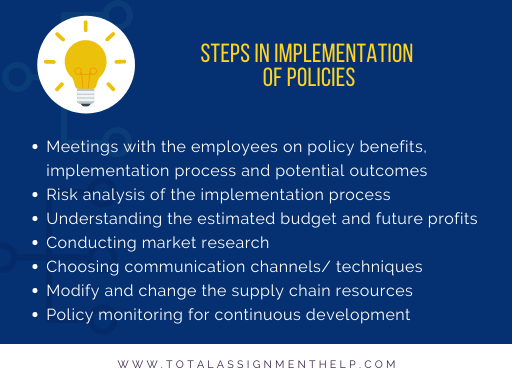
As mentioned earlier, each employee related to the process will be assigned their duties and that will involve a constant monitoring of the Commonwealth Bank of Australia sustainability approaches and find ways to better them in future. Communication is certainly a major factor and can help in avoiding issues and resolve unwanted conflicts. Hence, communication channels and the best ways to interact with the people are necessary and much important(The Benefits of Effective Communication in the Workplace, 2020). It is only through the right means of communication that can be done via social media channels; company Apps, Emails, meetings, personal feedback sessions, workshops and awareness improvement conferences that the policy can be made highly impactful.
It needs to be noted that a certain formal tone of articulation is necessary in order to make everyone listen and learn about the policy. Choosing a formal, yet softer and well-articulated language would be a part of the effective communication that can be beneficial for the implementation process.
2.2.2 Commonwealth Bank of Australia sustainability Policy Implementation Plan and Procedure report
A few strategies have been undertaken for continuous improvement in many areas of the policy implementation plan and management. The implementation plan comprises the following actions-
|
Activities/ strategies |
Responsibility/ jobs |
Time |
Estimated costs (in australian dollars) |
|
Risk identification |
One of the most important activities has been the identification of the potential risks and the issues that has been performed by the risk management theory and practice. This helped in understanding the nature of the issues and supported activities to eradicate them for smooth running of the resources. |
6 months |
5000 |
|
Managing teams |
A separate team has been appointed to specifically look within the needs and the operations of the stakeholders and understand their performances and their potentials as their prime responsibility. It was initially observed that several drawbacks and issues emerged while the plan was initiated, but with market research and a proper planning using effective means and style of communication, they were solved. |
8 months |
7000 |
|
Effective communication |
Processing effective communication across all levels is a part of the implementation plan that will help in reducing conflicts and develop positive employee relationships. |
3 to 4 months |
3000 |
2.3 Monitoring and reviewing the sustainability policy
2.3.1 Review the implementation of the policy and procedures
The current Commonwealth Bank of Australia sustainability performance is carried out through – environment policies, reducing carbon emission standards in the atmosphere, new statements on securing human rights in the society, Wealth Management Responsible Investing Framework schemes (Policies and practices, 2019). CBA has taken serious steps to channel their climate change policies through all their practices. They invested funds in making the carbon emissions monitored daily and reduce with time. The organization’s Environment Policy that was set in 2001 was renewed and revised 208, 2012, and in 2015(COMMONWEALTH BANK IMPLEMENTS SUSTAINABILITY POLICIES AND PRACTICES, 2015). After being a part of the United Nations Global Compact in 2009, the bank has initiated nine of their ESG Lending Commitments for managing Commonwealth Bank of Australia sustainability in all their operations. The overall feedback and the impact of the policy along with the related strategies have been highly positive (see Appendix). One of the striking success features of the CBA that is found in the official governance report of 2017 is the company’s association with the Bun gala solar project that is a $450 million investment and is highly beneficial in the field of sustainability and social development (Corporate Responsibility Report , 2017). Such sustainability actions and projects are in current trends and like other major global organizations, Commonwealth Bank of Australia sustainability is aiming to go eco-friendly and zero on carbon emission.
It can be articulated that activities like workshops, conferences, meeting, and interactive sessions at the workplace on the policy building and its implementation needs to be constantly carried out in order to gain better results. Identifying KPIs is required at specific intervals that will influence the employee recruitment and training and development sessions and schemes for the betterment of the organization’s overall business.
It is essential and much needed to provide feedback to the key stakeholders that might involve the employees working for the policy implementation plan, the resource planners, the financers and other staff of the bank. Understanding the type and nature of the work, the policy and the workplace environment, a strategic plan has to be made to provide feedback in the most effective way. Choosing a positive and effective communication technique and medium is necessary in order to gather and provide feedback without creating any misunderstandings or workplace conflicts.
2.3.2 Modified sustainability policy with your recommendations
It has been observed through the feedback and the overall research of the company and their operations and policies that some potential in facing threats and social stigmas are evident and could happen in future. Considering the feedback and the overall nature of the workplace of the CBA, it needs to be stated that few operations are required to be more people oriented and people friendly so that the common people of the country find equal interest to invest and think upon the policy of the Commonwealth Bank of Australia sustainability. Slight changes to the policy on the human rights need to be changed, and make it more people oriented in terms of addressing home and domestic violence activities. In addition, risk management teams at every level of the supply chain and the management has to be implemented for better results that can yield positive outcomes and more profits from the bank by making them more sustainable in their overall business. Thus a few specific recommendations will be-
- It is suggested to implemented risk management policies and new strategies to hinder threats
- It is recommended to make the policies more people friendly for the common people to use the policy schemes and make them effective in better ways.
- It is also recommended to constantly channel effective communication at all levels of the business to eradicate the birth and chances of unwanted conflicts and mismanagement issues.
3. Conclusion
This particular report on Commonwealth Bank of Australia sustainability has been educational and much enriching in terms of assessing the policies and practices of one of the largest banks in the Southern Hemisphere. The Commonwealth Bank of Australia has been observed to be implementing many strategies and policies for the improvement of their practices in more sustainable ways. It is observed through the report that policies need to be well implemented by receiving proper support, both financially and socially, from stakeholders. Risk management strategies are necessary to run policies without any hindrances alongside managing effective communication at all levels of the business. The recommendations that are provided will help the Commonwealth Bank of Australia sustainability to modify their current practices and make them better in ways that positively affect the stakeholders.
4. Appendix
The snapshots provided in the following content relate to the Bank’s annual governance reports and provide a clear understanding on the Bank’s performance over the years. This information has been used to draft the contents of the discussion where data and performance were analyzed to form the policies and elucidate the existing performance of the bank.
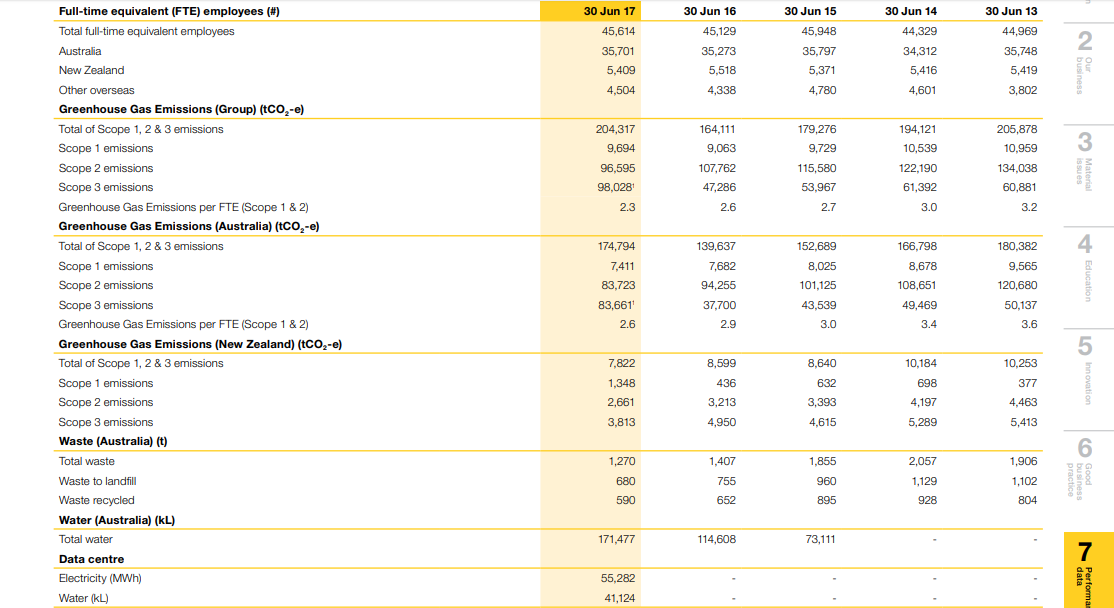
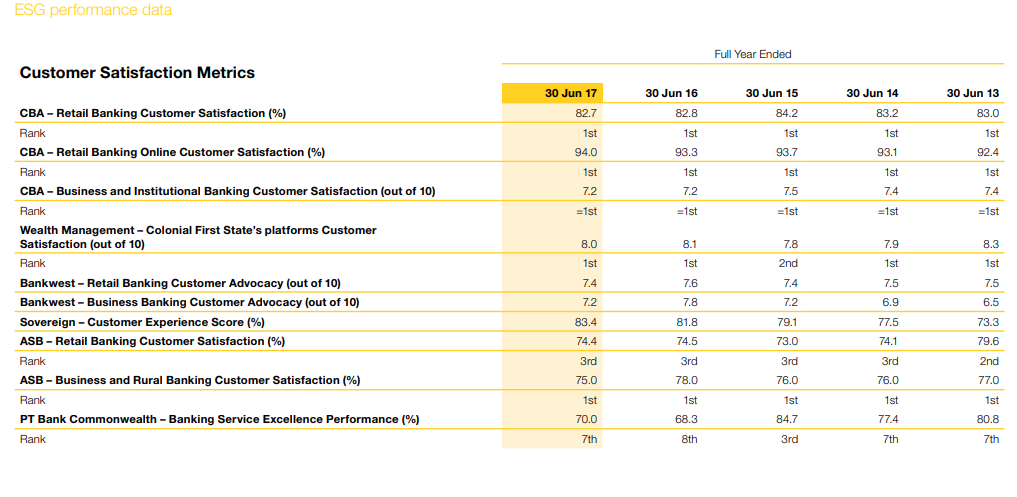
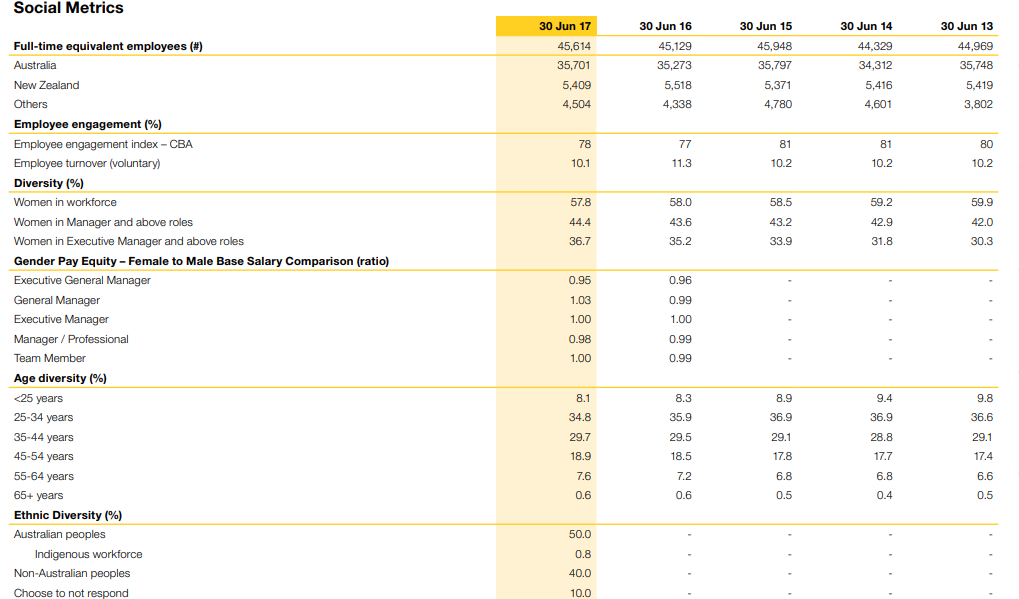
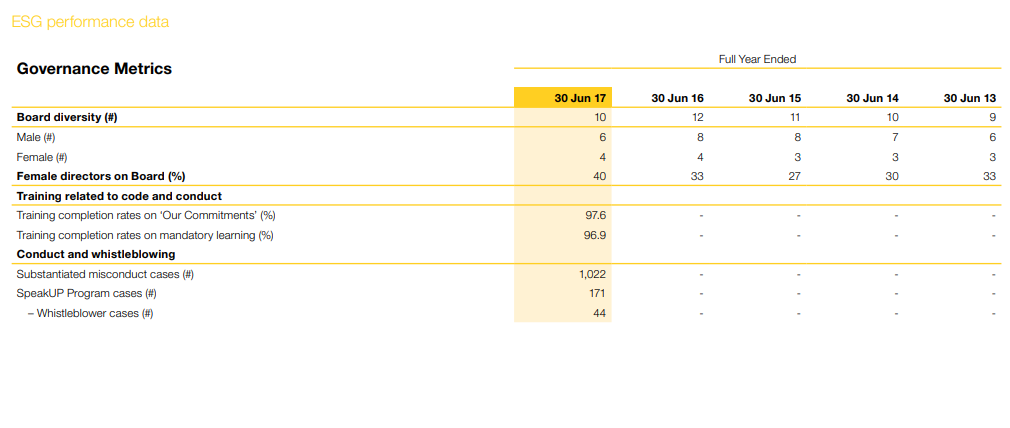
Reference List
8 BENEFITS OF RISK MANAGEMENT (BEYOND PROJECT CONTROL). (2017). Retrieved from tensix.com: https://tensix.com/2017/02/8-benefits-of-risk-management-beyond-project-control/
Ashford, K. (2019). Pros And Cons Of ESG Funds . Commonwealth Bank of Australia sustainability Retrieved from www.forbes.com: https://www.forbes.com/advisor/investing/pros-and-cons-of-esg-funds/
COMMONWEALTH BANK IMPLEMENTS SUSTAINABILITY POLICIES AND PRACTICES. (2015). Retrieved from commbank.com: https://www.commbank.com.au/about-us/news/media-releases/2015/commonwealth-bank-implements-sustainability-policies-and-practices.html
Corporate Responsibility Report . (2017). Retrieved from commbank.com.au: https://www.commbank.com.au/content/dam/commbank/about-us/shareholders/pdfs/corporate-responsibility/2017/2017-corporate-responsibility-report.pdf
Moving to Australia. The Commonwealth Bank. (2020). Retrieved from commbank.com.au: https://www.commbank.com.au/moving-to-australia.html?pid=100437&sc_psk=41067&sc_crkey=354644848459&c
Policies and practices. (2019). Retrieved from commbank.com.au: https://www.commbank.com.au/about-us/opportunity-initiatives/policies-and-practices.html
SUSTAINABLE BUSINESS PRACTICES How we implement sustainable business practices. (2019). Commonwealth Bank of Australia sustainability Retrieved from commbank.com.au: https://www.commbank.com.au/about-us/opportunity-initiatives/opportunity-from-good-business-practice/sustainable-business-practices.html
The Benefits of Effective Communication in the Workplace. (2020). Retrieved from nicenetwork.uk: https://www.nicenetwork.uk/the-benefits-of-effective-communication-in-the-workplace/
The importance of good communication in the workplace. (2019). Retrieved from michaelpage.co.uk: https://www.michaelpage.co.uk/advice/management-advice/development-and-retention/importance-good-communication-workplace












